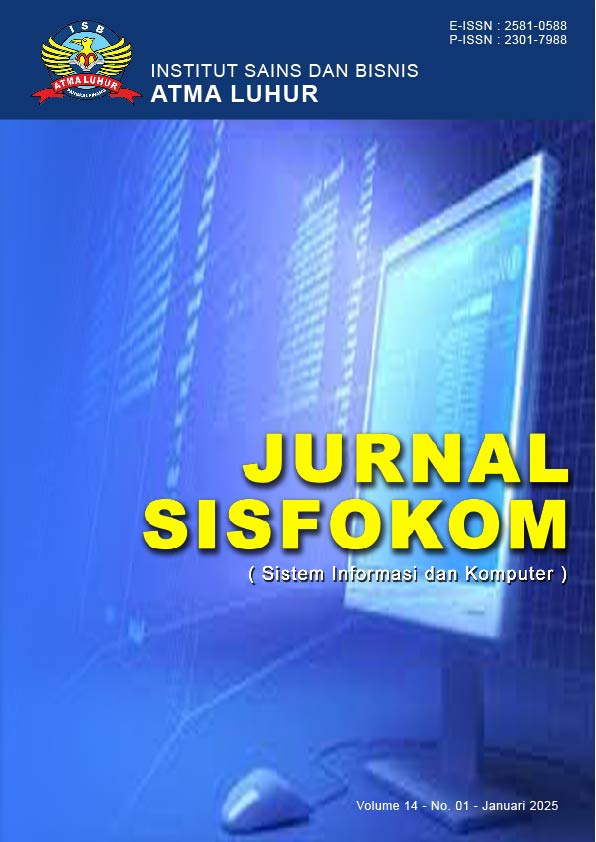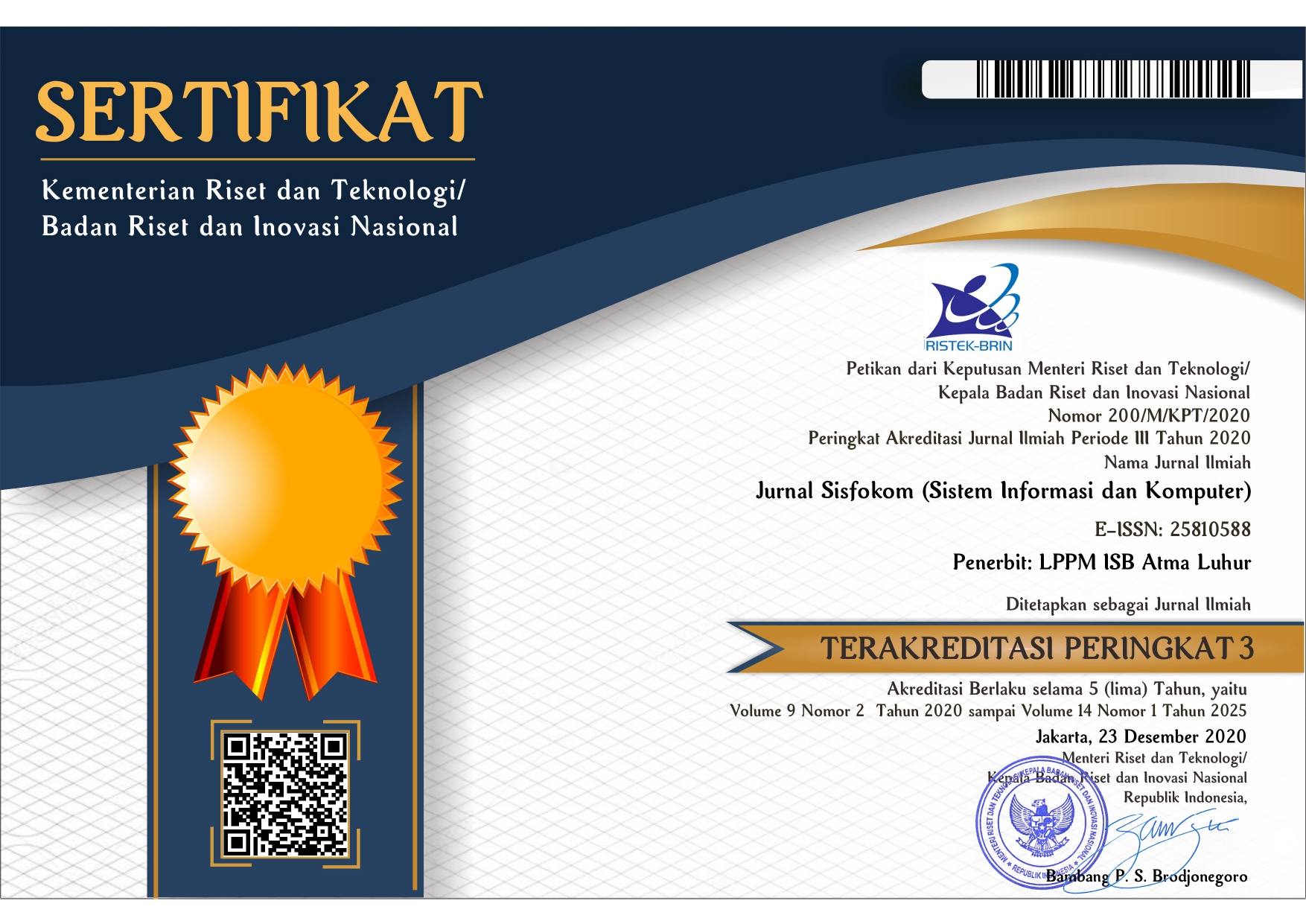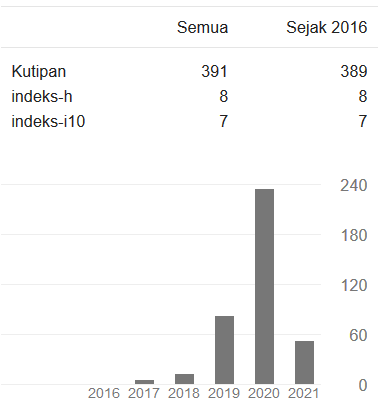Classification of User Expressions on Social Media Using LSTM and GRU Models
DOI:
https://doi.org/10.32736/sisfokom.v14i1.2370Keywords:
Emotion analysis, social media, sentiment classification, LSTM, GRUAbstract
Social media serves as a platform for sharing information. Through social media, users can interact with others and express their feelings and emotions. Therefore, emotion analysis plays a crucial role in understanding users' conditions regarding various issues and social events. This study aims to compare the performance of emotion classification models in analyzing and identifying users' emotions on social media. The research process includes data preprocessing, training, and model performance evaluation. The dataset used is derived from Twitter social media and is available on Kaggle. It consists of two main columns: text and label, with the latter categorized into six groups. The dataset undergoes several preprocessing techniques to ensure it is ready for model training. The model training process implements the architectures of LSTM and GRU to analyze the emotions contained within the text. The evaluation results show that the model achieves an accuracy of 93% for LSTM and 94% for GRU, indicating that the GRU model slightly outperforms the LSTM in classifying emotions in textual data. This research is expected to contribute to emotion analysis systems based on deep learning.References
D. Miller et al., How the World Changed Social Media. 2016. doi: 10.14324/111.9781910634493.
L. Minocha, P. Jain, A. Singh, and P. Pandey, “Social Media’s Impact on Business and Society: A Study,” in 2022 8th International Conference on Advanced Computing and Communication Systems (ICACCS), 2022, vol. 1, pp. 2078–2081. doi: 10.1109/ICACCS54159.2022.9784959.
C. Dayananda, H. P, S. B. Devamane, E. Aravind, I. D, and J. S, “Text Emotion Detection Using Machine Learning Algorithms,” in 2023 International Conference on Computational Intelligence for Information, Security and Communication Applications (CIISCA), 2023, pp. 304–307. doi: 10.1109/CIISCA59740.2023.00065.
S. M. Pardeshi, D. Chandra Jain, and R. B. Wagh, “A Qualified Study of Machine Learning Algorithms for Sentiment Analysis in Social Media,” in 2023 10th IEEE Uttar Pradesh Section International Conference on Electrical, Electronics and Computer Engineering (UPCON), 2023, vol. 10, pp. 577–581. doi: 10.1109/UPCON59197.2023.10434795.
M. K. Singh and S. Kumar, “Stress Detection During Social Interactions with Natural Language Processing and Machine Learning,” in 2024 International Conference on Expert Clouds and Applications (ICOECA), 2024, pp. 297–301. doi: 10.1109/ICOECA62351.2024.00060.
S. A. El Rahman, F. A. AlOtaibi, and W. A. AlShehri, “Sentiment Analysis of Twitter Data,” in 2019 International Conference on Computer and Information Sciences (ICCIS), 2019, pp. 1–4. doi: 10.1109/ICCISci.2019.8716464.
L. Sahu and B. Shah, “An Emotion based Sentiment Analysis on Twitter Dataset,” in 2022 IEEE International Conference on Current Development in Engineering and Technology (CCET), 2022, pp. 1–4. doi: 10.1109/CCET56606.2022.10079995.
K. Anbazhagan, S. Kurlekar, T. V Brindha, and D. Sudhish Reddy, “Twitter Based Emotion Recognition Using Bi-LSTM,” in 2024 International Conference on Trends in Quantum Computing and Emerging Business Technologies, 2024, pp. 1–5. doi: 10.1109/TQCEBT59414.2024.10545185.
S. P. Ayunda, N. Qomariasih, R. B. Hadiprakoso, and H. Kabetta, “Comparative Analysis of Deep Learning Models for Web Defacement Detection Based on Textual Context,” in 2023 IEEE International Conference on Cryptography, Informatics, and Cybersecurity (ICoCICs), 2023, pp. 287–291. doi: 10.1109/ICoCICs58778.2023.10276697.
S. Minaee, N. Kalchbrenner, E. Cambria, N. Nikzad, M. Chenaghlu, and J. Gao, “Deep Learning-Based Text Classification,” ACM Comput. Surv., vol. 54, no. 3, 2021, doi: 10.1145/3439726.
S. Rajendar, S. Ranganathan, T. Lakshmanan, V. Nachimuthu, and S. Paramasivam, “Human Stress Detection on Twitter: A Hybrid Approach using LSTM and Natural Language Processing,” in 2023 8th International Conference on Communication and Electronics Systems (ICCES), 2023, pp. 714–719. doi: 10.1109/ICCES57224.2023.10192829.
I. W. A. Suranata, “Pengembangan Model Prediksi Curah Hujan di Kota Denpasar Menggunakan Metode LSTM dan GRU,” J. Sist. dan Inform., vol. 18, no. 1, pp. 64–73, 2023, doi: 10.30864/jsi.v18i1.603.
I. Wayan Aditya Suranata, I. Komang Agus Ady Aryanto, D. Maneetham, I. Nyoman Kusuma Wardana, and P. Nyoman Crisnapati, “Physical-Chemical Properties Prediction of Chao Phraya River using Deep Learning Methods,” in 2024 10th International Conference on Smart Computing and Communication (ICSCC), 2024, pp. 601–607. doi: 10.1109/ICSCC62041.2024.10690816.
N. Elgiriyewithana, “Emotions.” Kaggle, 2024. doi: 10.34740/KAGGLE/DSV/7563141.
V. Ibrahim, J. A. Bakar, N. H. Harun, and A. F. Abdulateef, “A word cloud model based on hate speech in an online social media environment,” Baghdad Sci. J., vol. 18, no. 2, pp. 937–946, 2021, doi: 10.21123/bsj.2021.18.2(Suppl.).0937.
C. P. Chai, “Comparison of text preprocessing methods,” Nat. Lang. Eng., vol. 29, no. 3, pp. 509–553, 2023, doi: 10.1017/S1351324922000213.
M. Sergii V. and N. Oleksandr V., “Data preprocessing and tokenization techniquesfortechnical Ukrainian texts,” Appl. Asp. Inf. Technol., vol. 6, no. 3, pp. 318–326, 2023, doi: 10.15276/aait.06.2023.22.
S. Hochreiter and J. Schmidhuber, “Long Short-Term Memory,” Neural Comput., vol. 9, no. 8, pp. 1735–1780, 1997, doi: 10.1162/neco.1997.9.8.1735.
Y. Luan and S. Lin, “Research on Text Classification Based on CNN and LSTM,” in 2019 IEEE International Conference on Artificial Intelligence and Computer Applications (ICAICA), 2019, pp. 352–355. doi: 10.1109/ICAICA.2019.8873454.
D. M. Gunarto, S. Sa’adah, and D. Q. Utama, “Predicting Cryptocurrency Price Using RNN and LSTM Method,” J. Sisfokom (Sistem Inf. dan Komputer), vol. 12, no. 1, pp. 1–8, 2023, doi: 10.32736/sisfokom.v12i1.1554.
P. Eswaraiah and H. Syed, “A Hybrid Deep Learning GRU based Approach for Text Classification using Word Embedding,” EAI Endorsed Trans. Internet Things, vol. 10, pp. 1–8, 2024, doi: 10.4108/eetiot.4590.
S. Li and B. Gong, “Word embedding and text classification based on deep learning methods,” MATEC Web Conf., vol. 336, p. 06022, 2021, doi: 10.1051/matecconf/202133606022.
I. G. Ayu Nandia Lestari, D. G. Hendra Divayana, and K. Y. Ernada Aryanto, “A Concentration Selection In Study Programs Using SMOTE Techniques With Ensemble Learning Algorithms,” in 2023 5th International Conference on Cybernetics and Intelligent System (ICORIS), 2023, pp. 1–6. doi: 10.1109/ICORIS60118.2023.10352192.
G. A. Pradipta, R. Wardoyo, A. Musdholifah, and I. N. H. Sanjaya, “Radius-SMOTE: A New Oversampling Technique of Minority Samples Based on Radius Distance for Learning from Imbalanced Data,” IEEE Access, vol. 9, pp. 74763–74777, 2021, doi: 10.1109/ACCESS.2021.3080316.
P. D. R. Maulidiana, A. V. Vitianingsih, S. Kacung, A. L. Maukar, and D. Hermansyah, “Comparative Analysis of SVM and NB Algorithms in Evaluating Public Sentiment on Supreme Court Rulings,” J. Sisfokom (Sistem Inf. dan Komputer), vol. 13, no. 2, pp. 230–236, 2024, doi: 10.32736/sisfokom.v13i2.2116.
Downloads
Published
Issue
Section
License

This work is licensed under a Creative Commons Attribution 4.0 International License.
The copyright of the article that accepted for publication shall be assigned to Jurnal Sisfokom (Sistem Informasi dan Komputer) and LPPM ISB Atma Luhur as the publisher of the journal. Copyright includes the right to reproduce and deliver the article in all form and media, including reprints, photographs, microfilms, and any other similar reproductions, as well as translations.
Jurnal Sisfokom (Sistem Informasi dan Komputer), LPPM ISB Atma Luhur, and the Editors make every effort to ensure that no wrong or misleading data, opinions or statements be published in the journal. In any way, the contents of the articles and advertisements published in Jurnal Sisfokom (Sistem Informasi dan Komputer) are the sole and exclusive responsibility of their respective authors.
Jurnal Sisfokom (Sistem Informasi dan Komputer) has full publishing rights to the published articles. Authors are allowed to distribute articles that have been published by sharing the link or DOI of the article. Authors are allowed to use their articles for legal purposes deemed necessary without the written permission of the journal with the initial publication notification from the Jurnal Sisfokom (Sistem Informasi dan Komputer).
The Copyright Transfer Form can be downloaded [Copyright Transfer Form Jurnal Sisfokom (Sistem Informasi dan Komputer).
This agreement is to be signed by at least one of the authors who have obtained the assent of the co-author(s). After submission of this agreement signed by the corresponding author, changes of authorship or in the order of the authors listed will not be accepted. The copyright form should be signed originally, and send it to the Editorial in the form of scanned document to sisfokom@atmaluhur.ac.id.







